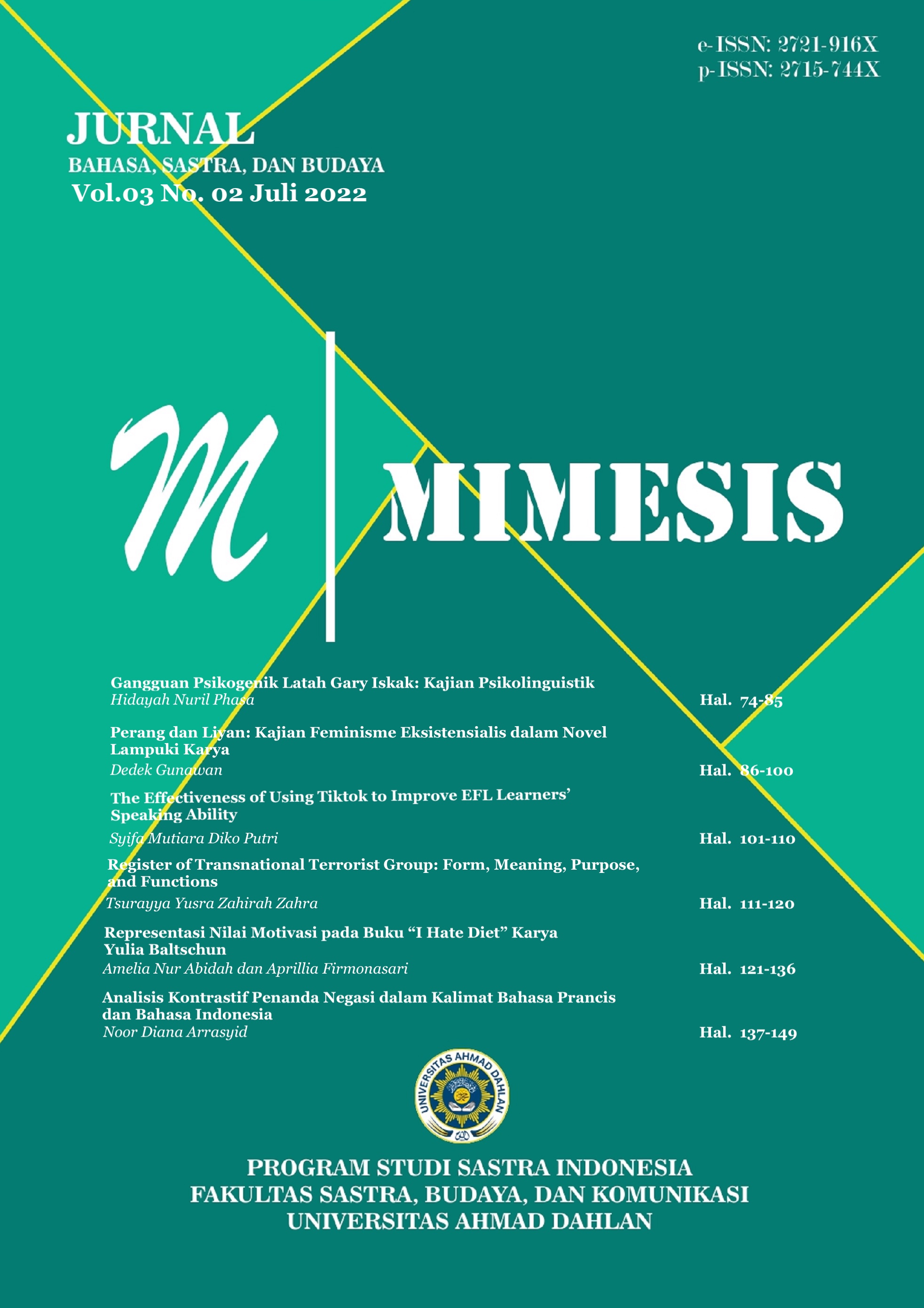REPRESENTASI NILAI MOTIVASI PADA BUKU "I HATE DIET" KARYA YULIA BALTSCHUN
DOI:
https://doi.org/10.12928/mms.v3i2.6239Keywords:
Multimodal Discourse Analysis, Reading Images , Seven Building Tasks , Motivational ValuesAbstract
Verbal language is vital in communication and is the most important means of interaction. By the significant role of verbal language, visuals are often less considered unnecessary, even though they could help to understand communication better. Verbal and visual language are interconnected and simultaneously build a strong, complete, structured text. This research focused on how a book writer communicates using two or more modes simultaneously, namely text and images, which is called multimodal discourse analysis, particularly social semiotics. This study analyzes the illustrated book "I Hate Diet" by Yulia Baltschun. Using a descriptive qualitative method that refers to the theory of reading images, Kress & Leeuwen's (2006) analysis relates to the existence of representational and interactive meanings with images divided into three aspects: information value, salience, and framing. In connection with the data analysis in the form of text or verbal, it is analyzed using the theory of seven development tasks by Gee (2011). The results indicated the meanings of the image or visual illustrations supported by verbal or text analysis. There are several representations of meaning in it, namely the meaning of motivational invitations and warnings or meanings that remind.
References
Barker, C. (2000). Cultural Studies: Theory and Practice. London: SAGE Publications. Ltd
Baltschun, Yulia. (2020). I Hate Diet. Denpasar: Ananas Mahartha Indonesia.
Halliday, M.A.K. & Matthiessen, Christian, M.I.M. (2004). An Introduction to Functionnal
Grammar, 3rd edition. Great Britain: Arnold
Halliday, M.A.K. (1994). An Introduction to Functional Grammar, second edition. New York: Routledge, Chapman and Hall, Inc
Kress, G. & Van Leeuwen, T. (1996). Front Pages: (The Critical) Analysis of
Newspaper Layaout. In Bell, Allan. and Garret, Peter (Eds), Approaches to Media Discourse. Oxford: Blackwell
Kress, Gunter & Van Leeuwen T. (2006). Reading Image: The Grammar of Visual Design. 2nd Edition. New York & London: Routledge.
Gee, James Paul. (2011). Discourse Analysis: What Makes it Critical? Dalam Roger R (Ed). An Introduction to Crtitical Discourse Analysis in Education (23—45). New York & London: Routledge
Gombrich, E. H. (1982). The Power of Language; How Discourse Influences Society. London and Oakville: Equinox.
Zainuddin. (2017). Analisis Multimodal dalam Teks Iklan dalam Perspektif Semiotik. Bahasa dan Seni
Harahap, April. (2015). Analisis Metafungsi Visual Multimodal teks Mangayun pada Masyarakat Mandailing.
Pathia, Laelatul. (2020). Pemanfaatan Instagram Sebagai Media Dakwah (Analisis Multimodal Instagram KH Mustofa Bisri pada Akun @s.kakung). Mediasi. 01(03)
Sinar, T. S. (2014). Teori dan Analisis Wacana: Pendekatan Linguistik Sistemik Fungsional. Medan: Mitra.
Yanda, Diyan Permata & Ramadhanti, Dina. (2019). Analisis Wacana Multimodal dalam Novel Bidadari Bermata Bening Karya Habiburrahman El-Shirazy. Jurnal Gramatika, 4(2), 214-226.
Downloads
Published
Issue
Section
License
Copyright (c) 2022 Amelia Nur Abidah, Aprillia Firmonasari

This work is licensed under a Creative Commons Attribution-ShareAlike 4.0 International License.
License and Copyright Agreement
In submitting the manuscript to the journal, the authors certify that:
- They are authorized by their co-authors to enter into these arrangements.
- The work described has not been formally published before, except in the form of an abstract or as part of a published lecture, review, thesis, or overlay journal.
- That it is not under consideration for publication elsewhere,
- That its publication has been approved by all the author(s) and by the responsible authorities tacitly or explicitly of the institutes where the work has been carried out.
- They secure the right to reproduce any material that has already been published or copyrighted elsewhere.
- They agree to the following license and copyright agreement.
Copyright
Authors who publish with Mimesis agree to the following terms:
- Authors retain copyright and grant the journal right of first publication with the work simultaneously licensed under a Creative Commons Attribution License (CC BY-SA 4.0) that allows others to share the work with an acknowledgment of the work's authorship and initial publication in this journal.
- Authors are able to enter into separate, additional contractual arrangements for the non-exclusive distribution of the journal's published version of the work (e.g., post it to an institutional repository or publish it in a book), with an acknowledgment of its initial publication in this journal.
- Authors are permitted and encouraged to post their work online (e.g., in institutional repositories or on their website) prior to and during the submission process, as it can lead to productive exchanges, as well as earlier and greater citation of published work.











